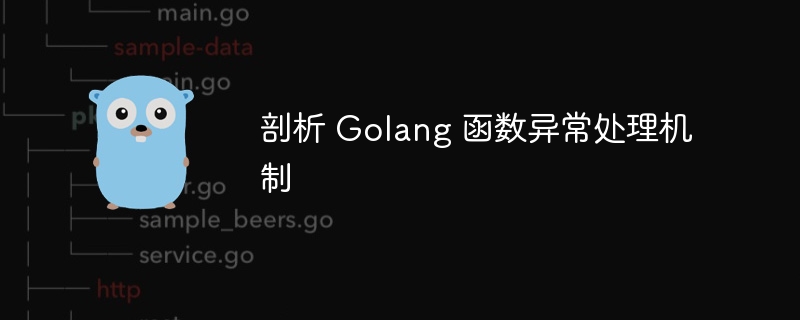
The function exception handling mechanism in Golang throws exceptions through panic(), and recover() captures unhandled exceptions in the defer function. When panic() is called, the program terminates immediately and looks for the nearest defer function, which is executed in the order of declaration. recover() catches the exception in the first defer function that did not terminate abnormally and continues execution. This mechanism allows error conditions to be handled gracefully and prevents unexpected program termination.

Analysis of GoLang function exception handling mechanism
Function exception handling in Golang is through the built-in panic() and recover() function implementation provides effective handling of error conditions outside the normal execution flow of the program.
Raising exceptions: Explicitly raise exceptions by using the panic() function. panic() Can accept any type of parameters, representing the details of the exception.
Recover exceptions: Use the recover() function to capture exceptions that are raised but not handled. recover() Only valid in defer function.
Process:
panic() is called, program execution terminates immediately and starts looking for the nearest defer function. defer Functions are executed starting from the bottom of the stack in the order in which they are declared. defer function that has a recover() call and is not terminated abnormally, recover() will capture exception and continues execution in its code block. defer function sequence until the defer function sequence ends. The following is a sample code that uses the function exception handling mechanism to handle division by zero errors:
package main
import "fmt"
func divide(x, y float64) float64 {
defer func() {
if err := recover(); err != nil {
fmt.Println("除数为零,无法执行除法。", err)
}
}()
return x / y
}
func main() {
num1 := 100
num2 := 0
result, err := divide(num1, num2)
if err != nil {
fmt.Println("处理除以零错误:", err)
} else {
fmt.Println("结果:", result)
}
}In the above example:
divide() The function captures the exception of division by zero through recover() in the defer function. main() The function handles the caught exception and outputs an error message to the user. Therefore, by using the function exception handling mechanism, error conditions can be handled gracefully and the program can be prevented from terminating unexpectedly.
The above is the detailed content of Analyzing Golang function exception handling mechanism. For more information, please follow other related articles on the PHP Chinese website!
 How to define variables in golang
How to define variables in golang
 What are the data conversion methods in golang?
What are the data conversion methods in golang?
 What are the commonly used libraries in golang?
What are the commonly used libraries in golang?
 What is the difference between golang and python
What is the difference between golang and python
 How to solve the problem that wlan does not have a valid ip configuration
How to solve the problem that wlan does not have a valid ip configuration
 OKEX official website
OKEX official website
 Which version of linux system is easy to use?
Which version of linux system is easy to use?
 Introduction to input functions in c language
Introduction to input functions in c language




